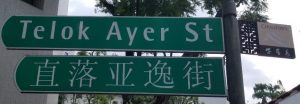Singapore’s languages are as diverse as its people and cultures. The population is mainly comprised of ethnic Chinese (76.2% of the population), Malays (15.0%), and ethnic Indians (7.4%) (“Demographics”, 2019) and consequently, Mandarin, Malay, Tamil make up three of the four official languages of Singapore (S.l., 2014). The final official language is English (S.l., 2014), which is also the first language taught in school, the main language used in the workplace (“Languages”, 2019), and of course, the default language that people use when speaking with me. Despite my own limited speaking experiences, it is easy and interesting to observe, record, and reflect on the public use of languages used in Singapore.
The majority of signs, especially those that are public, show all four of the official languages of Singapore. The information is displayed first, and largest, in English, then second in Mandarin, third in Malay, and lastly, in Tamil. This format is consistent throughout all the signs that I observed. An example of this can be seen below in my photo of the Little India Arts Belt sign.  Nevertheless, within specific ethic neighborhoods, such as Chinatown, Little India, and Kampong Glam, smaller street signs only present information in English and the one corresponding mother-tongue of that area, so Mandarin, Tamil, and Malay respectively. An example of this can be seen below in my photo of a Telok Ayer Street sign. Telok Ayer is a street located in Singapore’s Chinatown, and so consequently, the languages used on this sign are English and Mandarin.
Nevertheless, within specific ethic neighborhoods, such as Chinatown, Little India, and Kampong Glam, smaller street signs only present information in English and the one corresponding mother-tongue of that area, so Mandarin, Tamil, and Malay respectively. An example of this can be seen below in my photo of a Telok Ayer Street sign. Telok Ayer is a street located in Singapore’s Chinatown, and so consequently, the languages used on this sign are English and Mandarin.
Within Chinatown, there are also some individual private enterprise signs that show information exclusively in Mandarin. In these instances, the enterprises were often authentic Chinese restaurants, and so the signage was an important design element, but was not necessarily used for its communicative value, as there were people from all different ethnic backgrounds seated inside. This is a similar experience noticed by Leeman and Modan in their article where they discuss how the liberal use of Chinese characters in Washington DC’s Chinatown was not always used to communicate, but rather for its aesthetic value (Leeman and Modan, 2009, pg. 347).
In general, however, I think that Singapore’s use of all official languages on signage promotes these languages as a valuable cultural element. This is ultimately different from DC’s Chinatown where language was not constructed as “a tool to empower language minorities, promote interaction and community building”, but rather, for commercialization (Leeman and Modan, 2009, pg. 358). Instead, I think that Singapore is able to balance communication, ethnolinguistic value, local heritage, and community within its multicultural society.
This balance also extends past the public signage. For example, Singaporean schoolchildren are primarily taught in English, but are also required to learn their mother-tongue to make sure that they don’t lose contact with their traditions. In this way, and many others, the Singapore Government presents language as a “valuable cultural element worthy of preservation in its own right” (Leeman and Modan, 2009, pg. 358). Singaporean people themselves also keep their languages alive and part of society by publicly communicating with each other in their mother-tongues. For example, although English is the main language used in the workplace, my colleagues will often chat in Mandarin, and you always hear people speaking a wide range of languages on the street or on public transport.
As such a multicultural country, Singapore’s linguistic landscape could easily have been a confusing jumble, but instead, the government has achieved a fine balance between protecting its’ citizens’ heritage, communicating efficiently, and facilitating an environment that allows lots of different ethnic communities to live together harmoniously. I am excited to see how Singapore adapts in the future as it becomes an even more diverse society.
Works Cited
Demographics of Singapore. (2019, June 24). Retrieved from https://en.wikipedia.org/wiki/Demographics_of_Singapore
Languages of Singapore. (2019, June 11). Retrieved from https://en.wikipedia.org/wiki/Languages_of_Singapore
Leeman, J & Modan, G. (2009), Commodified language in Chinatown: a contextualized approach to a linguistic landscape. Journal of Sociolinguistics, 13(3), 332-362.
S.l. (2014, July 03). Language. Retrieved from https://www.justlanded.com/english/Singapore/Singapore-Guide/Language/Language
Rebecca,
I really enjoyed your essay! I think it is interesting how Singapore is able to maintain such linguistic diversity. I thought that it was interesting that you mentioned that children in Singapore are also required to maintain their mother tongue. I’ve read a little about how linguistic minorities, such as those who speak Hokkien, have experienced significant oppression in Singapore aiming to repress the use of non-dominant languages. Have you noticed this in your time in Singapore?
Hi Elizabeth.
Thank you for reading my essay. I haven’t noticed this yet, but it sounds interesting and I will see if I can notice it in my time left in Singapore.